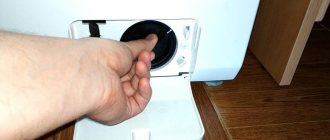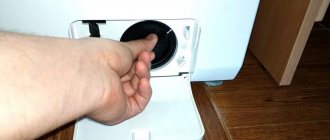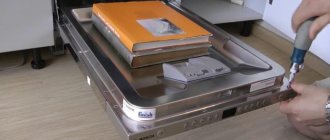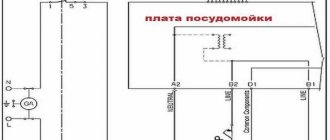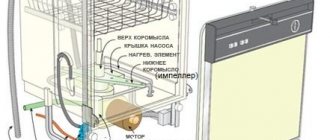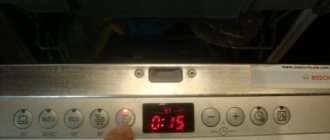Read our article and find out what to do if your dishwasher is clogged.
After loading the dishes and turning on the “Start” button, did you hear that the dishwasher was humming, but did not fill with water? Or did the machine start the wash cycle, but stopped during the draining stage and refused to discharge waste water? It is necessary to take urgent measures to correct the problem. The most common cause is blockages in the system.
Basic rules of care
When operating this household appliance, adhere to the following rules:
- To ensure that your dishwasher serves you for a long time, check the water inlet hoses frequently. If necessary, clean them with a toothpick.
- Dry the rubber gasket in the door once every 2 months.
- Before washing, be sure to clean the dishes from food residues. Try not to overload the car.
- To keep your dishes sparkling clean, choose the right dishwasher cleaner. Check that the glitter and salt compartments are well filled.
To make cleaning your dishwasher easy and to prevent damage, please note that the following dishes cannot be washed in it:
- cutlery made of wood (partially or completely), since they lose their presentation, and the glue used in the manufacture of such utensils does not withstand high temperatures;
- decorative glass products that are very sensitive to external influences;
- rare porcelain or antique dishes of special manufacture;
- disposable plastic tableware;
- crystal with lead particles;
- products made from synthetic materials sensitive to high temperatures;
- copper and tin utensils;
- stainless steel items;
- articles of applied art;
- old dishes whose coating is not heat-resistant;
- products with silver and gold inserts, since when washed, the color may change and the dishes may fade.
Special cases
None of the measures taken help? What to do in this case? Call the master! Most likely, some control element has failed. Only a qualified technician can identify such a breakdown and replace it with a new one.
Incorrect operation of the software module. When the electronic “brain” incorrectly analyzes the operation of the device and sends incorrect programs through the control module, the outflow of water may stop. Such a failure can be diagnosed only with special devices. The failure can be corrected by reflashing and replacing the unit with a new one. This is the most expensive type of dishwasher repair work and the risk of causing serious harm when repairing it yourself is quite high. Checking the operation of the electronic unit is the prerogative of an employee of a specialized service center.
Damage to the water level sensor. The force of water pressure inside the dishwasher is measured by a special device - a pressure switch. They come in two types - electronic and mechanical and do not come into direct contact with water during operation. All measurements are carried out through a special air membrane and fed to the sensor. The cause of failure of the unit may be oxidation of the contacts, a puncture in the pressure switch tube, the ingress of detergent into it, or a manufacturing defect. Diagnosis of a breakdown is carried out using a multimeter, so calling a qualified technician is a necessity, not a whim.
How to remove scale, grease and blockages using traditional methods
One day a customer came to our electronics store who bought a dishwasher from us about six months ago. She threw a real scandal, saying that we sold her defective equipment, which so quickly began to function poorly. To help you understand the situation, dirt is no longer completely removed from the dishes.
The lady began to demand the return of money for the goods or payment for the repair of a broken car. Then I had to ask the customer a counter question: how often did you clean such an expensive device, did you use special products, and how often did you use them? The answer simply infuriated me. She said she often used the tablets to clean dishes and the dishwasher.
That is, in six months of operation the hose, drain or filter has never been cleaned. Then I had to remind the woman once again about the frequency of “hygiene” of equipment and talk about an effective folk remedy against scale, which every housewife can find in her kitchen. You can effectively clean scale at home with citric acid. To do this, you will need 200-400 grams of acid, which needs to be poured into the dishwasher, after which you need to start the normal dishwashing mode. Just a few days later, the customer came with words of apology and thanked her for the useful advice.
If you don’t want to find yourself in the same awkward situations, then you should pay more attention to technology and take note of several popular methods for cleaning your dishwasher from scale, grease and clogs.
- As you already understood, the first remedy is citric acid. It perfectly removes scale, blockages in the drain and greasy build-ups on important elements. The only rule when using such a “hot” product is to rinse the device again using the normal washing mode to completely remove any remaining lemon juice.
- The second option is lemon juice. In order to get rid of fat on the door and rubber bands, just squeeze out the juice of 3 fruits and wipe the indicated elements with it, then wipe them dry.
- Another effective remedy for scale and blockages is vinegar. To clean with vinegar, you will need to pour 400 ml of the product into the bottom of the basket, turn on the unit to heat the water, start the device and stop it approximately halfway through the cycle. If the blockage is minor, you can continue the washing process after 30 minutes. If you need to get rid of a more serious blockage, then leave the machine in this state overnight and finish the cycle in the morning.
- A riskier method is bleach. If the internal parts of your dishwasher are made of stainless steel, then you will have to abandon this product immediately. If not, know that bleach is a great way to combat mold. To do this, you need to pour 200 ml of the solution into the dishwasher and run a full wash cycle at high temperature.
Don’t forget about preventing the occurrence of fat deposits, unpleasant odors, and scale. “Fairy”, “Fairy Platinum” (soda tablets), “Antinakin” or “Finish” for dishwashers can help you with this.
Remember that poor performance or breakdown of equipment is often caused by improper care. Hopefully, after reading this article, you will become more diligent about taking care of your dishwasher and can affordably clean it yourself. By the way, don’t forget about your other friends from the world of technology, for example. Subscribe to updates, invite friends and always be the first to know the news of the technology world.
How to clean parts and remove blockages
To solve sewer problems, you can call a repairman or do it yourself. For example:
- clean the contaminated area with a thin brush on a wire;
- disconnect the siphon and rinse it with water;
- add special powder and use a plunger.
What to choose is up to you. You also need to clean the drain hose: under pressure from a tap or mechanically (using a brush).
You will have to devote more time to internal problems. Let's look at how to clean a clogged filter.
Drain filter
Before starting work, disconnect the PMM from the network and turn off the water supply. Proceed like this:
- Open the camera door.
- Pull out the lower dish basket.
- Unscrew the filter and metal mesh from the pan.
- Rinse under the tap. Additionally, you can use a soft brush and toothpick for particularly difficult stains.
Remove water from the container in the tray with a sponge. Remove the pump damper. Pull the cover to the side and then towards you. Additionally, you may need to unscrew the screws. Check the impeller for blockages. If everything is in order, then inspect the pump and its parts.
Drain pump
You need to disassemble the dishwasher to get to the pump. Remove all baskets from the chamber. Pull the car out into a free space and place it “on its back”. Then do this:
Unscrew the screws or unfasten the latches of the bottom cover (bottom). A float sensor can be attached to the back of the bottom. Carefully unscrew the mounting bolt and unfasten the wiring. Once you gain access to the circulation block, you will notice that the pump is attached to the side. Unscrew its screw. Disconnect the wiring plugs.
Additionally, you can inspect other parts, hoses, and pipes.
Spray
Everything is simple here:
- The lower rocker arm is located near the drain filter.
- Scroll it and remove it from its seat. On some models, you may need to press down on the latches.
- Rinse the part with water. Additionally, the injectors are cleaned with a toothpick.
Be sure to inspect the top sprayer and its openings. Sometimes scale accumulates in the holders to which the sprinkler is attached.
Intake filter
The mesh can be cleaned by disconnecting the inlet hose from the PMM body. If a part is clogged with scale, place it temporarily in water with the addition of citric acid. It is recommended to clean the mesh at least once every six months.
Types of blockages and reasons for their occurrence
If the PMM does not drain or does not fill with water, the reason may be a blockage. Depending on the brand of dishwasher - Bosch, Siemens, Ariston, Indesit, Veko - an error code may appear on the display. Deciphering the code indicates a problem that needs to be found and fixed.
If no error appears on the display, you will have to look for the cause of the problem on your own. First you need to determine the type of blockage: external or internal.
External factors:
- The sewer system, pipes, or the connection between the drain hose and the sewer system are clogged.
- The siphon is clogged (when connected through it). If the siphon is poorly permeable, it is difficult for water to drain out of the sink. This may serve as an additional sign for verification.
- The drain hose was bent and twisted. This happens when the connection is incorrect. The hose may be crushed by a foreign object.
What to do in this case? Check that the drain system is connected correctly. Turn off the water supply, disconnect and install the hose correctly, without kinks. Also disconnect its end from the sewer and clear the blockage with special means. Don't forget to check and clean the siphon.
Hair Ball Clog in Drain Pipe
Internal blockage appears if you did not properly clean the dishes before loading them into the chamber. Pieces of food, parts of napkins, and toothpicks flow into the tray along with the water. If dishes break during washing, then fragments also penetrate into the filter and drain.
What parts can become clogged with debris:
- Drain filter. It serves as a barrier behind which the pump impeller and the pump itself are hidden. The water passes through the filter so that the water goes down the drain or begins to circulate through the chamber again. Therefore, it is recommended to clean it twice a month. Better yet, check the filter after every wash.
- Spray. Water is supplied by a circulation pump to the sprinkler, from where it flies out of the nozzles (holes) under pressure. The nozzles become clogged - no water flows, the system generates an error or stops working.
- The drain is clogged. If the filter fails, food debris penetrates further into the pump and drain hose. To remove foreign objects, you will need an article on how to disassemble a dishwasher. We will also describe the sequence of work in this publication.
- Inlet filter. At the inlet to the fill valve there is a fine mesh that stops large particles of debris from the water supply and rust. Over time, the part becomes clogged and needs to be cleaned.
How to clean the dishwasher filter if it is clogged
It often happens that dishwasher filters become dirty. This significantly complicates the operation of the device and reduces the quality of washing. If the blockage is not cleared in a timely manner, it may lead to damage to the device. Cleaning your dishwasher filter periodically will help avoid many problems.
How to clean the filter?
Causes of filter clogging
The main reason is large food residues on the dishes. Before loading dishes, you should thoroughly clean the plates from any remaining food and be sure to rinse them with warm running water.
But even this event will not completely eliminate the possible clogging of the filter, because fat accumulates on it, which does not completely dissolve in water. Detergent residue can also cause clogs. Scale and plaque also leave their mark on the surface of this element.
How to remove the filter
In household Bosch or Electrolux dishwashers, the filters are located in the lower internal part of the device, above them there are rocker arms for distributing water and a heating element. The structure of a Bosch dishwasher is shown in the photo.
Before removing the filter for cleaning, you should unplug the device from the power supply, then use a sponge or rag to collect excess water. Only then can you remove the filter itself. By the way, the remaining parts - water distributors, heating element - should also be cleaned of scale and other contaminants.
It is very easy to understand that the filter is clogged and requires immediate cleaning. The machine begins to work much worse than before. The quality of dishwashing decreases, the appliance begins to make some noise, and water remains at the bottom. All this indicates that it is time to urgently clean the filter.
How can you clean the filter?
There are several available ways to clean the filter in your dishwasher:
- Using dishwashing detergent and cleaning powder. They can be applied using an old toothbrush, then rinse thoroughly with running water, and the procedure can be repeated if necessary.
- Another effective remedy that will help get rid of fat is baking soda. It can be used along with table salt, which also helps clear grease stains. But it’s better to dilute the powder with water and apply the slurry with a dishwashing sponge, then rinse.
- The last method, which will help not only get rid of fat, but also limescale, is citric acid; for this, the part should be soaked in the solution for several hours, then washed with soapy water. Vinegar works in a similar way. If there is no citric acid, it will completely replace it.
It often happens that the filter located on the water supply valve becomes clogged. You should not forget about cleaning it, even if not too often.
The water that passes through it every day is not of high quality. It may contain a lot of salts or lime. Sometimes rust particles come out of the pipes.
If the dishwasher filter is not cleaned on time, the water will draw in much more slowly.
Preventive measures
A few simple rules will help avoid many problems:
- All food residues should be removed from dishes before loading them into the machine. It is advisable to rinse it with warm water to partially remove the grease.
- To wash dishes, you must use special liquids, powders or tablets; A household product will not work.
- It is advisable to use special water softeners - this will reduce the accumulation of scale on the heating element and water distributors.
- The filter must be removed and washed at least once every two weeks. And once every three months you should carry out a general cleaning inside the device, because dirt and grease accumulate throughout the entire internal surface of the machine, which causes an unpleasant odor and the formation of fungus.
It is advisable to clean the dishwasher filter and clean the inside of the appliance as often as possible. Anyone can do this on their own.
All these measures significantly extend the life of the equipment and help avoid the need for expensive replacement of some parts and components.
In the video you can see detailed instructions for cleaning the dishwasher filter from clogging.
Getting rid of limescale
When caring for your machine, you need to decide not only how to clean it from grease, but also how to get rid of scale.
. The heating elements are inaccessible for direct contact; disassembling the machine to gain access to them from the inside is strictly not recommended. Scale can only be dealt with using chemicals. The products can be either specialized, purchased in a store, or “homemade,” that is, from improvised ingredients.
Professional anti-scale products
To remove scale, acid-based products are used, which, by triggering a chemical reaction, destroy the plaque on the heating elements.
The most popular dishwasher detergents are “Fairy” and “Finish”
.
- “Fairy” (or “Fairy Platinum”) is available in the form of a gel or tablets with inclusions that prevent the appearance of scale and the spread of rust.
- “Finish” is a gel-like preparation produced in 250 ml bottles. The container with the product should be placed in the dishwasher and run a cycle with a water temperature of 60−70°C.
Both products have already received many rave reviews from dishwasher owners.
Many people complain about the poor quality of various tablets: the dishes are not washed, smudges remain, and the product itself remains on the plates and cups. But Fairy capsules do a great job: in 40 minutes they perfectly wash simple dishes, frying pans, and frying pans with grease build-up.
Irina, 32 years old.
I like Fairy All in 1: these are capsules with powder and gel. The white powder is the actual detergent, and the gel is a rinse and water softener. After them, the dishwasher shines, and there is no need for special cleaning.
Sofia, 35 years old.
I have a Bosch dishwasher, which after three years has become terrible at cleaning dishes. I bought Finish and followed the instructions: I removed all the dishes, removed the sticker, turned them upside down and placed them at the very bottom. The cycle started as long as possible, with a temperature of 65 degrees. When the cycle ended, the machine smelled pleasantly of lemon, and the dishes now clean perfectly again!
Nastya, 28 years old.
Remedies for plaque from scrap materials
The price of professional anti-plaque products seems exorbitant to some.
. Thrifty housewives can resort to home remedies that will effectively help clean the dishwasher.
Choosing a specific cleaning product is the right of every housewife. The main thing is not to neglect the rules of caring for equipment and not to ignore symptoms indicating contamination:
- A louder pump sound indicates that the filter is dirty.
- Poorly washed dishes indicate the presence of blockages and deposits on the baskets and blades.
- An unpleasant smell, red and black spots on the door are a sign that grease has reached the secluded corners, the seals are overgrown with dirt, and the machine itself needs to be dried more often.
Grease, dirt and residue make the dishwasher ineffective. Take care of it carefully, and then the equipment will last a long time.
Attention, TODAY only!
Good afternoon, dear readers. Quite often I have to deal with such a problem as customer complaints regarding malfunctions in dishwashers. Often, excited and angry people come to the store to return goods because they were allegedly sold a low-quality product, without even realizing that they themselves have become a “stumbling block” for expensive equipment
The reason for this may be improper care, which is why it is so important to know how to clean a dishwasher at home, which will be discussed in today’s article
Folk remedies
Soda
Baking soda removes old stains and eliminates unpleasant odors. You need to pour soda into the tray of the machine, then turn it on at the highest temperature for a short time.
Vinegar
Effectively disinfects equipment and removes dirt and grease. To do this: fill a plate with vinegar (preferably use distilled white vinegar) and place it on the top shelf. Turn on the device at maximum power. After work, leave the door open to eliminate the unpleasant odor.
Lemon acid
Will help in the fight against scale. Pour 300 g of acid into the machine and run it at full power.
To keep your kitchen appliances in working order, you need to know how to clean a dishwasher at home. The answer to the question must be found in the operating instructions for the device. The manufacturer lists the detergents and cleaning products that are allowed. Budget models, unlike automatic ones, are subject to exclusively manual cleaning. At the same time, you need to remember that you should not rely entirely on automation.
During the first month of operation, the inner surface of the device is covered with a layer of fat. If you do not clean it promptly, then after a few weeks you will need to contact a service center. In most cases, maintenance is performed using a limited list of substances, the use of which inside the unit will not cause harm to it. Unfortunately, not everyone is in a hurry to get acquainted with it. As a result, the number of equipment failures increases.
The first thing the housewife should remember is that you should not use aggressive chemicals and acids. Even if labeled “delicate,” the reagent can still damage the interior surface. The second rule concerns the amount of substance used. Jewelry precision is the key to long-term health of the dishwasher.
The following tips will help you avoid many problems at the stage of practical operation:
- It is recommended to ventilate the unit after each use - this reduces the rate of formation of fatty deposits;
- The thicker the layer of fat inside, the less time you can dry the dishes;
- After completing the sanitary measures, the “insides” of the machine must be dried for at least 40 minutes, otherwise mold will form.
Regularity and consistency are the key to a healthy dishwasher. You can get rid of fat using the recommended list of substances. They are poured into a tank specially designated for this purpose, after which the “cleaning” mode is activated. The main thing is to quickly remove fatty deposits that can harm the mechanical elements of the device.
Tips for caring for your dishwasher
- follow the rules for operating the device: load dishes correctly (place plates, pans in the lower compartment, cups in the upper compartment), and the devices should not come into contact with each other;
- After each use of the device, wipe its surfaces, seals, and door with a damp cloth;
- remove all dirt immediately, without waiting for a “general” wash;
- Periodically deep clean the device, wash filters, baskets, blades, seals, and housing.
At the end of the wash cycle, always leave the machine door open unless your appliance is designed to dry automatically (many modern Bosch models have been improved with built-in fans, so the inside of the appliance always remains dry.
Regularly performing simple cleaning procedures for your household appliance will improve its performance and extend the life of the machine.
Prevention: how to wash a dishwasher
Sanitary procedures will not take much time if you follow some rules
You need to pay attention to the hose responsible for releasing water. Every 2 months it should be cleaned with a soft brush and rinsed
In order to avoid having to literally peel off all sorts of dirt at the end of the month, you should inspect the dishes before each wash. The surface is freed from large and small food residues, otherwise the mechanical parts of the product will quickly fail.
In addition to the tips listed above, there are a number of others:
- Each machine has a maximum weight - an indicator characterizing the dishwasher’s ability to wash a certain amount of dishes. You cannot exceed it even slightly.
- Even the most expensive unit will not be able to wash dishes if the wrong cleaning agent is selected. This must be purchased taking into account the characteristics of the cookware itself, the prevailing types of contamination and the manufacturer’s recommendations.
- Before starting work, you should check the salt sections of the substance responsible for the formation of shine. It is forbidden to turn on the dishwasher if the listed elements are in insufficient quantities.
- The dishwasher needs to be rinsed regularly. This can be done in manual and automatic mode, depending on the model. For example, Bosch machines, located in the middle price segment, can be washed by pressing a few keys. The main thing is to choose a substance for this procedure that is recommended; it is better to refuse, otherwise you may lose warranty service.
How to avoid problems
By adhering to the operating rules, you can prevent problems. What do we have to do:
- It is good to clean utensils from food residues.
- Clean your dishwasher regularly.
- Clean the drainage filter twice a month, and the bulk filter once every six months.
- Remove scale from parts. Use special salt.
- Dry the hopper after the wash cycle.
This way you can fix problems with your own hands, as well as prevent their occurrence. A video on the topic will help you:
https://youtube.com/watch?v=YW2X1Reu9K4
• Remove the filter by turning the head counterclockwise upward.
• It is almost non-removable; only the mesh can be removed.
• Rinse the insides of the mesh filter thoroughly with hot water, if necessary, use a brush and detergents.
• Using a sponge or small rag, suck out any remaining water from the filter compartment and inspect it thoroughly for dirt, food scraps or other foreign objects.
• Now let’s check the pump blades; to do this, remove the cover protecting them. There are models where it can be easily removed by pressing it until it clicks and pulling it up, but for me you need to unscrew one screw with a hex head; on some there may be two.
• This is what the pump blade protective cover looks like.
• Check the pump impeller; it should rotate without any snags; remove any remaining food or other debris.
• Reassemble everything in reverse order.
Cleaning bosch dishwasher blades
Since we’ve already taken on the repairs, it’s a good idea to clean the blades at the same time; the holes in them also get clogged with food debris, which need to be cleaned occasionally for the machine to work properly.
We remove the upper blade; to do this, turn the special “lamb” half a turn counterclockwise.
Under the pressure of hot water, we clean the holes with a regular match or toothpick.
The lower blade is held on by four latches, two on each side; carefully unfasten it, pulling it up, clean it and put it in place.
Now it is possible to check the result of the work performed. If you don’t know how to reset the remaining time on your model, then just pour a couple of liters of water and then safely turn on the Bosch dishwasher or any other.
She must pick up the previously started cycle and finish it as expected by draining the water into the sewer, which will be a successfully completed repair with her own hands.
We watch a video about the advantages of a dishwasher, as well as how to load dishes correctly.
«>
Cleaning sprinklers from debris
A sprinkler can easily damage a dishwasher, because despite the fact that the water from the hose has already been cleared of large particles, it still contains microsand and calcium salt, which the filter allows through.
The spray system also depends on the water hardness, since at high levels the rubber seals on the rotating parts may weaken. You need to inspect them at least once a month in order to notice a malfunction in time.
To clean the sprayer you need to:
- Remove the basket with the rocker, including the lower level;
- Bend the latches and sprayer blades, pulling them upward;
- Inspect the seals;
- Rinse the blades, nozzles and components under normal water;
- Return everything to its original position.
Despite the fact that fasteners may differ from each other on different PMMs, they have the same assembly principle. For proper assembly, you must use the instructions included with the dishwasher.
How to eliminate the causes yourself
Each of the breakdown options has its own simple solutions, which you can try to cope with yourself. Before starting repairs, you must carefully read the instructions for the machine and unplug the power cord from the outlet. Then remove the drain hose from the sewer and lower it into a bucket. If liquid suddenly gushed out in a sharp stream, then the most likely cause of the blockage is a clogged sewer or drain. If water still remains in the dishwasher, you need to look for the cause further by first collecting it manually and draining the internal tank.
Kink in the drain hose. During general cleaning of the apartment and direct care of the unit itself, its location may temporarily change. Therefore, the drain hose can bend anywhere and prevent water from flowing freely. You need to carefully inspect it for correct installation and correct the position.
Sometimes the hose becomes clogged with mechanical debris (bones, solid food particles) and loses its capacity. Then you need to disconnect it from the dishwasher and remove it from the connection to the sewer and rinse it under strong water pressure.
Poor water pressure. If there is poor pressure in the city water supply system, then it will enter the device in insufficient quantities and can cause a general malfunction of the electronic module. The wash cycle will not start correctly and the sequence of commands may be incorrect.
Clogged sewer in the apartment. If the device has a common outlet with a sink and water does not drain well from there, then you need to try to eliminate the mechanical blockage using special chemicals such as “Mole” or a cable for cleaning the sewer system. Most often, the root cause of poor water drainage in such cases is pipes clogged with plugs of hair, congealed fat or food debris.
A blockage in the general sewer system in an apartment building or private building will also prevent the direct outflow of water. It’s very simple to understand this - not only the water from the kitchen appliances does not drain, but, in general, everything in the house.
Drain filter clogged. Almost always, users of household appliances neglect manufacturers' recommendations for operation. The device is not properly maintained and this leads to failure. When using a dishwasher, the manufacturer strongly recommends cleaning cutlery from any uneaten food particles before putting it in. Otherwise, they heavily clog the fine mesh of the internal filter and prevent the waste liquid from draining. This problem is quite easy to deal with. You just need to take out the removable filter, clean it under running water and install it back.
Clogged blades most often occur due to poor quality of city water. When it is very hard, the small outlet holes become clogged with limescale and the flow of water goes in the wrong place. It is necessary to remove the blades, clean them with a toothpick, rinse them under a strong stream and insert the impeller back.
Drain pump clogged. When the internal drain is clogged, water sits in the internal tank and does not drain through the drain hose. If all of the above measures do not help, then the cause may be the drain pump. You can find its location by carefully studying the instructions. You should unscrew the protective cover and try to rotate the pump blades with a stick or pencil. When movement is difficult, you should try to remove the foreign object and screw the pump back in.
Decoding the e25 code on the dishwasher display - read more in our article.
What is causing the malfunction?
There are several main reasons that can prevent drainage. These can be either mechanical problems or disruptions in the operation of the control center.
Attention! Before carrying out an initial inspection of the device, you must disconnect it from the direct power source, in accordance with the rules of safe operation.
Blockages in the following components can interfere with the smooth operation of the dishwasher:
- apartment sewer system
- internal removable filter
- drain pipe system
- filter in the water supply valve
- drain pump
- blade elements.
Before carrying out diagnostics, you need to make sure that there are no obstacles to the drainage of waste water due to a kink in the dishwasher drain hose.

